#how to use pictory
Explore tagged Tumblr posts
Video
youtube
Pictory AI review 2024, best AI video generators
Pictory.ai: Create professional videos in a flash with artificial intelligence. Transform your text, blog articles, and scripts into captivating videos with automatic captions, engaging visuals, and advanced customization. Online video editing tool, AI video generator, text to video, automatic captioning, video content creation, video marketing, video marketing platform, easy-to-use video editing software, social media video marketing. Ideal for marketers, influencers, content creators, and anyone looking to increase their online visibility. Free trial available.
Fast Video Editing: Speed Up Your Video Workflow with AI, best AI video ...
#youtube#digital#marketing agency#growth hacking#online business#seo#pictory ai#pictory ai video generator#pictoryaivideocreator#illustrated tutorial#illustrated review#pictory ai tutorial#pictory ai review#pictory demo#honest image review#how to use pictory#Pictory review and demo#how to use Pictory AI#pictory promo code#illustrated text to video#illustrated voiceover#Pictory AI text to speech#artificialintelligence#captioning#texttovideo#videotools#videoediting#videomarketing#videocreation
1 note
·
View note
Text

- A l y x -
heya @doctorizzykleiner i hope u like this one too! 😅💜
#half life#half life 2#hl#half life alyx#alyx vance#half life fanart#my art#my drawing#my fanart#my digital drawing#half life alyx vance#sorry guys been busy on my 1st year in college#i finally got a round stylus pen! :-)#here it is my alyx fanart!#hl alyx#valve#valve games#btw i also use some body pictorial poses pictures becoz I don't know how to make some good poses-
14 notes
·
View notes
Text
Sigil Magick: Illustrating Your Intent
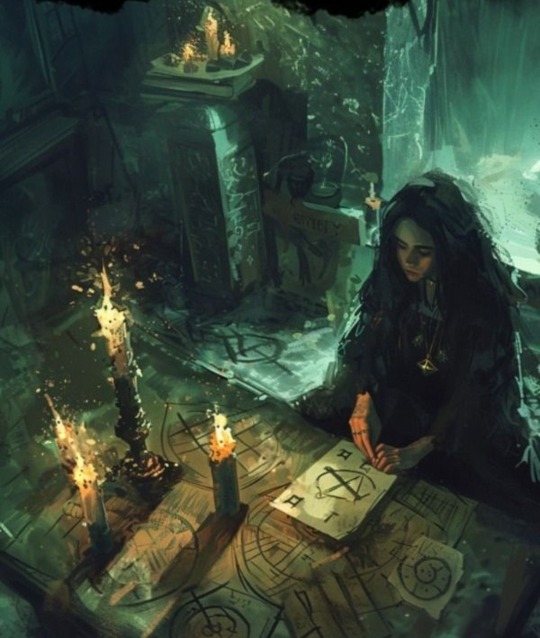
Sigils are a cornerstone of contemporary and chaos magick and function as keys to unlock the doors of reality and bend it to one’s will. These potent symbols serve as physical embodiments of one’s intentions, cast into existence through the fusion of art and willpower.
The crafting of a sigil begins with a clear and focused intention, which is then worked into a unique symbol through a creative magickal process. The magick practitioner inscribes deep personal meaning and style into their designs, making each unique to its artist. Sigils are ideal tools for manifesting your desires, imbuing objects with specific purpose and energy, protecting spaces, and communicating with the spirit world and should be used responsibly.
Origins
The practice of crafting sigils traces its roots to the ancient world but was modernized in the early 20th century by the works of Austin Osman Spare, an occultist and artist. He introduced the method of creating magical symbols by condensing letters of a desire into an abstract design. Aleister Crowley, too, influenced the practice by intertwining sigils with ceremonial magick, embedding them with a rich esoteric significance.
Some occult grimoires employ sigils as a means of contacting spirits, for example; Ars Goetia, The Book of Oberon, and Pseudomonarchia Daemonum.
Basics of Sigil Magick
Sigil magick emerges from the belief in one’s ability to manifest their focus into reality. Through a process of creation, a sigil becomes much more than mere ink on paper—it is the illustrated essence of desire. Individuals can use sigils as focal points for their will, empowering these symbols through meditation or ritual to enact change. The universe of sigils is vast and varied, types of sigils include:
• Pictorial Sigils: Intuitive symbols drawn from the subconscious
• Runic Sigils: Combinations of runic alphabets that resonate with specific energies
• Word Sigils: Derived from statements of intention, where letters are crafted into a unique symbol
Correspondences also serve a purpose in this class of magick, in order to help align one's intent to universal energies. As an artist crafts their sigil, they intertwine traditional symbols with personal significance, creating a bridge to the metaphysical world. Some relevant correspondences are:
• Numerology: Numbers carry vibrations that can enhance a sigil’s purpose.
• Zodiac Signs: Celestial influences infused to fine-tune the focus.
• Elements: The classic forces of Earth, Air, Fire, and Water lend their power to sigils, grounding them in natural harmony.
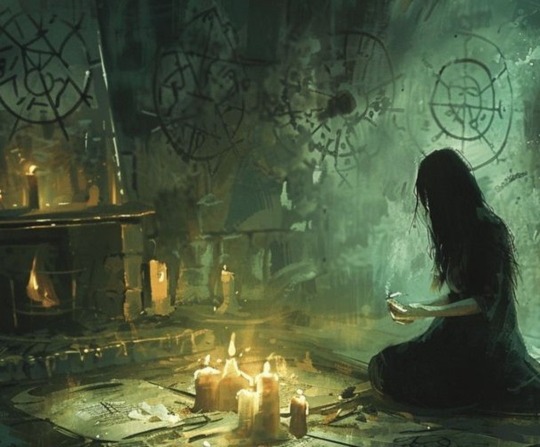
Sigil Creation
Before you take pen to paper, first envision your intent with clarity and purpose This may involve some deep introspection into the true nature of your desires. A precise intention lays the foundation for the sigil's power. Once ready, write out your intention and cross out any duplicate letters. From here a couple different methods can be utilized. Naturally you could always draw your sigils from pure instinct, creating spontaneous shapes to represent your intentions, but there are other techniques available.
The Wheel
This method employs a wheel to be used as a map for drawing your sigil. Simply start at the first letter of your intent and draw lines to each subsequent letter. Example:
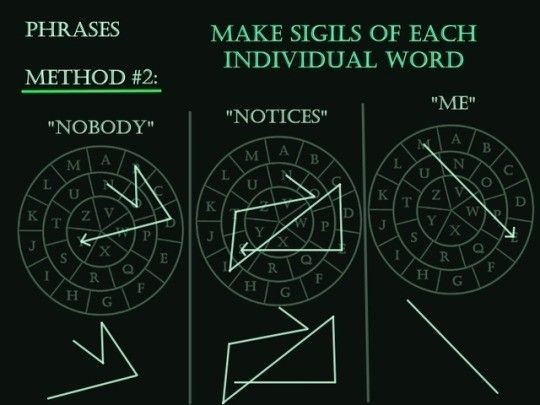
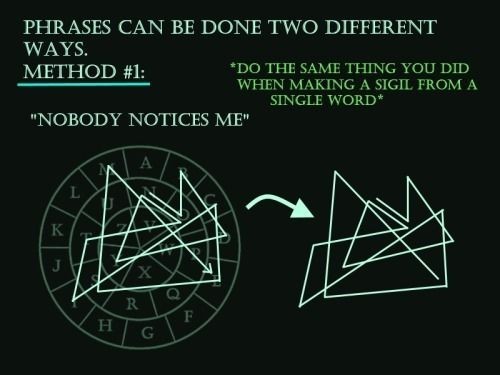
My Method
I make my sigils by breaking up the letters to create shapes. I will often decorate with extra shapes, symbols, and pictures as well. Here is a simplified example of my sigil creation process:
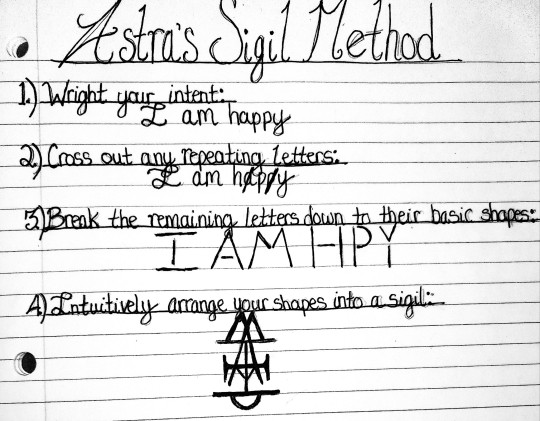
Next you must charge your sigil. Charging is the act of infusing the sigil with energy. The creator might enter a meditative state, focusing intently on the sigil while envisioning their intentions intertwining with the design. This act of focused concentration serves to embed the intention within the sigil, making it a beacon for the desired change.
Passive and Active Sigils
Intentioned sigils fall into either the passive or active sigil category based on how that sigil's energy is best utilized. Passive sigils are usually drawn on the body, item, or surface and then left alone to release their power over time. Active sigils involve some action to trigger the release of the sigil's energy, such as burning, burying, soaking with water/oil, and more. Some sigils can be used both passively and actively, but most will fall into one category.
Spirit Sigils
Many spirits and deities have sigils that represent them and these can be powerful catalysts for interacting with these beings. If the spirit you're working with doesn't have a sigil made for them (or even if they do) you can design your own symbol to connect with that spirit. Follow the same process, but instead of focusing on your intent, focus on the spirit/deity and connecting with it. You can even perform a ritual and provide an offering to invite the spirit into your space. This will allow you to draw divine inspiration straight from the source. Here are some examples of spirit/deity sigils, as well as some I created:
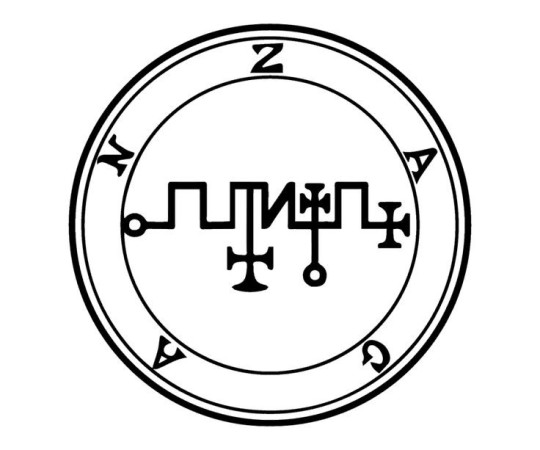
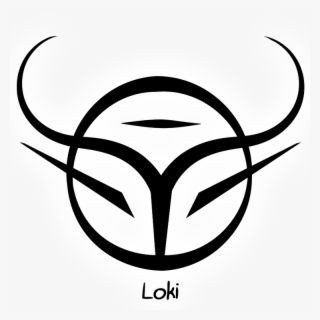
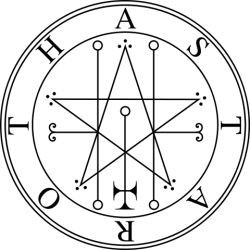
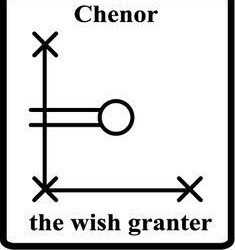
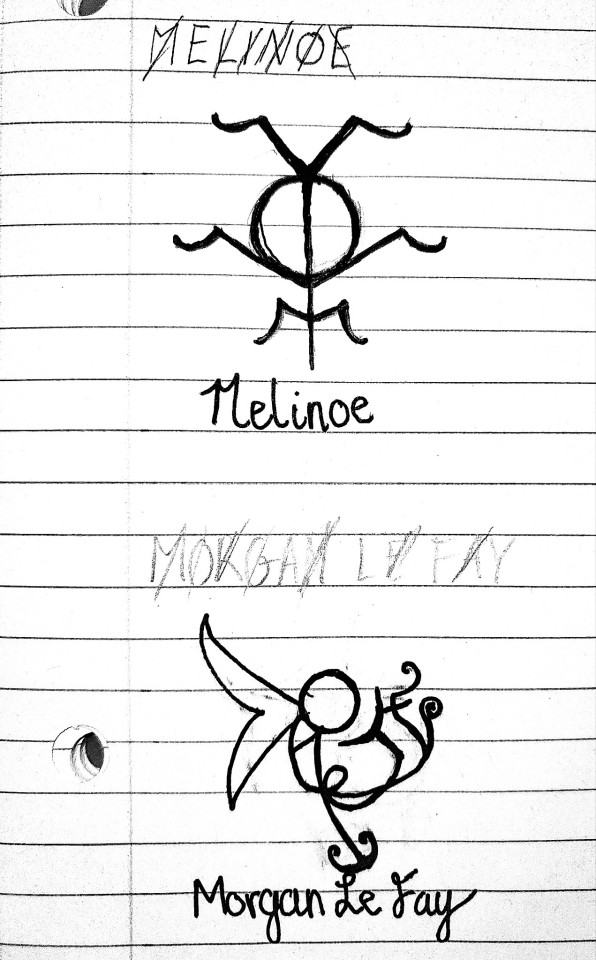
#magick#witch#witchcraft#sigil#sigils#sigil magic#sigil magick#chaos#chaos magick#chaos magic#chaos witch#satanic witch#lefthandpath#dark#satanism#demons#demonolatry#spirit work#spell work#spellwork#spell#spells#spellcasting#symbology#symbolism#symbols#eclectic#witchblr#witch community#pagan
636 notes
·
View notes
Text
Factory Reset
Winter (dom) x Male Reader (sub)
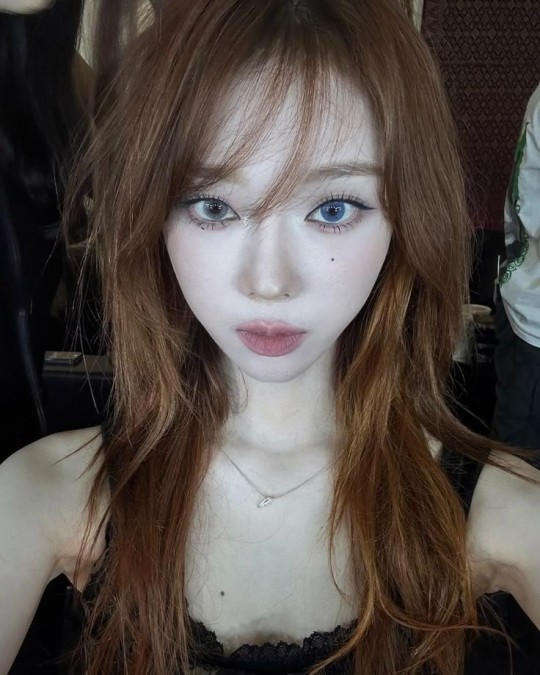
Synopsis : reader here is a gay dude turned straight by dommy bestfriend Minjeong in a drinking session, as she reveals some intimate confessions to you, how reader's body makes her act weird and stuff. How she feels so horny when she sees you using crop-tops and short shorts.
You were always this feminine, and always been exposed to feminine things like, making your hair longer, manicuring, dolls, playing house, and make up and other stuff that makes girls, girls. And you've always been friends with girls, especially your introverted childhood best friend Minjeong.Your Mother typically influenced you but Minjeong technically molded you with the very image you desired.
What's fascinating is that, though Minjeong was surrounded by boys most of her childhood she still held a very strong feminine aura around her. That made you adore her more, platonically.
But for Minjeong, it's different...
She always saw you as more than a friend... She liked you, even though you were different, well... More like, love you. Romantically, and now she might as well confess to you. But that doesn't end there, she has been planning to get you drunk as fuck, and then confess... But why make you drunk first? Her motives are far insidious and disgusting. She had always dreamed of stripping you off of your clothes, revealing your pale and soft skin for her to devour. This started ever since both of you stepped foot in puberty, whilst she helped you be the person you are today. She dreamed of a body that encapsulated her dream lover.
The day that Minjeong will finally confess to you and make you hers has come.
Y/N's POV
"Gosh, is my blush alright?" I sighed as my blush was a bit too light. I turned my attention to Minjeong, who is also prepping herself for today's pictorial. Well it is my birthday and it's gonna be lit! "Hey, is my blush alright?" I asked Minjeong, "Yeah, it's a bit too pale, let me fix it." She answered quickly. As she approached me, her touch was delicate. 'This feeling is a bit weird, sure. This is normal between but her touch for the past few weeks has been a bit too touchy. Like intimate touchy, maybe she's just being caring. Thats all',I thought to myself.
Finally at campus grounds, there was a day long event happening. We tried staying but we got bored. "Ugh, this so fucking boring..." I groaned as I checked through my phone, I could see Minjeong glancing at me by my side. As she was about to speak I cut her off, "Lets go some- oh wait what was that Minjeongie?" I quickly realized she was trying to tell me something. "As I was saying, lets go back to my dorm" She smiled as she checked her phone for the time she quickly added, "Lets go have a drink" she smiles. I thought it was a good idea, but oh boy... This feels like trouble, so I brushed it off. As we bought some booze, and fled to her dorm. I was met with a very strawberry-like scent that enveloped my nose, hugging them softly. I sat at one of her beanie bags and slouched relaxedly. "So, why did you think about getting booze? Trying something new?" You smirked at her, "Um... Y-Yeah and I wanted to tell you something" she responded her head down, mostly being shy. "Ohh~" I sang as she preped our booze. We took sip after sip after sip, I got tipsy but Minjeong? Damn she's tough. "W-Woah, you're not even tipsy yettt~" I groaned as my tipsy-ass getting beaten by someone who just had her first drink ever.
Winter POV
'This is my chance! O-Ok I'm gonna go for it!' I thought to myself, seeing
Y/N so tipsy and weak. I have to seize the opportunity, "So Y/N... I actually like you, like a lot..." I told Y/N as he was fixing his crop-top. "And... Please, can we at least try?" I quickly added. "W-Woah... I've never thought of you actually like me and, I don't know..." He grabbed the hem of his collar. And looked at me, "You know that I'm gay ri-" I cut him off, as I kissed his lips. Pressing them hard, his expression shocked.
As he tried pushing me away, I grabbed both of his hands. Pinning him to the ground, "M-Minjeong, s-stop!" He shouted, as I attacked his lips again. His legs were squirming, also trying to push me away. I stopped kissing him, seeing him so flustered and out of breath only made me eager to make him mine. "Minjeong, w-what has gotten into you?!" Y/N exclaimed, as I ripped his crop-top revealing his lushes pink small nipples.
He tried covering them but I grabbed his hands and pinned them down. Licking his hardened nipples, made him moan. "Nngghh... M-Minjeo- s-stop..." His moans were music to my ears. As it only turned me on, I removed one we of my hands in his hand. I pulled down his short-shorts, revealing a very pink strawberry colored tip.
That was hardened, the size though was no joke... It was the perfect size for me, about 6 inches in length and 2 inches in width. He tried covering them with his unpinned hands but his strength was no match from mine. Focusing back on his nipples again made him shiver, that was enough for him to not resist me anymore. "S-Slow down, Minjeong... Please" his breathing is shaky, I grabbed his waist.
Removing my hands from pinning his other hand, I licked them. They're so tasty... Salty, sweet and so perky. I bit one of them, I heard a hiss from him. That quickly turned me on. His hardened cock still exposed, so I slowly kissed my way down. Kissing his nipples, down to his chest, and then his stomach, down to his waist and then his hardened cock.
"O-Oh, f-fuck... Minjeong, slow do-" As I put my mouth down on his cock, it was so hard yet the texture was soft. It tasted salty, yet it left an addictive taste. When I continued to taste him, his moans were starting to get louder.
Authors POV
"M-Minjeongiee~, g-guh... Hah" His voice clearly in ecstasy, he held Minjeongs head to keep on attacking his member. Minjeong feasted on him, as the flavor of him only made Minjeong more and more addicted to him. "Ahh, C-Cummi- M-Minjeong! p-please s-stop!" Without warning Minjeong fastened her pace, making him reach his orgasm. His orgasm made him shake compulsively, as Minjeong's tongue swirled around him. Hr continued to orgasm, Minjeong drank everything. She stood up, removing her lower garments. Revealing a dripping entrance... She proceeded to grab you by the hair, moving it up and down. Giving you the taste of a woman that longed for you, for so many years. "Y-Y/N t-this feels so g-good" Her voice shaken, the fact that your face is being use for her pleasure. Your voice is dampened by her entrance, juices that leaked out from her you desperately choke on, you however tried to get a hold of her, trying to push her away. But her resilience and determination alone, made your defenses weak. As her climax was near, she pushed you deeper into her, making you savour everything that leaked out from her. She exploded, squirts of her juice came flying through your throat and nose, making you gag. Of course you can't drink it all, some you spat out and most of it you drank.
Her leg shaken, as her hand dropped your hair. Your weakened state left you open for her next assault, "M-Minjeong..." You heave your breath, "S-Sorry... Y/N its ju-" Winter got caught off as Y/N's hand was on her hands... Winter was shocked how the one that she just assaulted held her hand so softly... "I-Its alright, you're drunk ri-" Y/N's lips were yet attacked again. Winter sensing Y/N is enjoying this, she left no time for him to finish his sentences. "Y-Yeah..." As her hand floated on his crotch again, she moved her hand hastily. Catching Y/N off guard, she inivetibly harden the kiss. Making Y/N weak again, she then moved herself. Aligning her entrance down to her sexually confused friend. "I'll make you mine..." Winter sounded desperate, "G-Go ahead" Y/N's voice shaky and high...
As Winter lowered herself, pleasure struck the two. Stunning them for a second, they both look at each other. Winter looked like she had just hit the jackpot, Y/N looking more like a renewed person. Both of them had different thoughts yet both shared the same goal right now, to feel each other's love. As Winter ravaged Y/N's cock, Y/N felt Winters tightness embracing him. His perfectly shaped cock drove inside Winter, making them both moan. Winter hugged Y/N, as Y/N did the same. Both felt tremendous pleasure, Winter pushed Y/N down. "I'm going to ride you and turn you into my bitch" Winter said coldly, as Y/N just smiled and kisses her hands. "Sure, make me your bitch" Both smiled as they shared a kiss with each other... Winter now riding Y/N, this sensation made Winter more and more addicted to this kind of act. Y/N moaning like a bitch in heat, Winter fasten her pace as both are nearing... "Fuck... Feels... So... Amazing" Winter moving up and down vigorously as Y/N lay down. Drooling as his limit has already reached. Both of them are in a euphoric state, Winter and Y/N jolted as both came to their climax. Winter collapsed in Y/N's soft and pale chest, Y/N cathing and hugging Winter in the process, "W-Wow... I never thought I could do it with a woman..." Y/N gasping for air, "M-Me too, I thought I can never do this with you..." Winter having the same state with Y/N. Both looked at each other for one-last time, "I love you" both kissed and embraced each other. As the sun rises, both felt something new inside of them.
Y/N thinking he'd be this person to have a man loving him, instead the woman that was with him throughout his journey, was the only person that truly wanted and understood him, loved him more than anyone.
While Winter thought the love of her life will be taken away by some random person yet Winter took his heart...
Many Years had passed and both had children, 3 in fact. Both of them are still surprised to this day that both of them are able to be together, forever.
The End
397 notes
·
View notes
Text
There's this really cool horror trope I've noticed lately of a villain being introduced in a simplified, unscary form, but later evolving into something so detailed and terrifying, it takes your breath away.
This is not the same as a traditional metamorphosis like in body horror cinema because the trope relies on the medium it uses to sell the scare.
Minor spoilers for Don't Hug Me I'm Scared. Major spoilers for Inscryption and I Saw The TV Glow
To introduce you to the concept, I'm just gonna show you the Care Hound from Don't Hug Me I'm Scared.
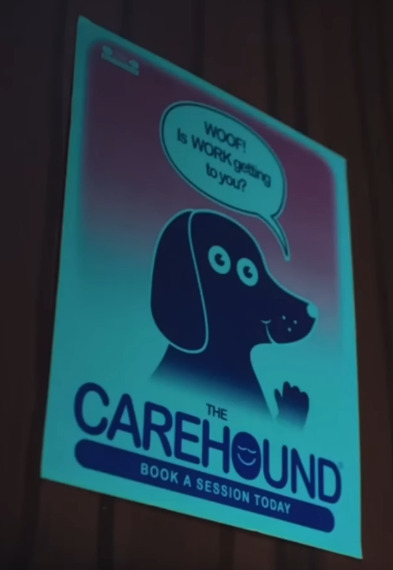
It's the Carehound alright, or rather a pictorial representation of the Carehound. But how do they look in real life?

Ah.
Like the rest of the show, this is both terrifying and hilarious. You think because it's a 2D representation of the dog that the eyes on the side of the head are just artistic license, but then he turns toward you and you realise no actually, he literally has two eyes on each side! Genius. 10/10 joke.
But you see what I mean right? You're given a disarming image of the antagonist so that later, they can pull the rug out from under you with the truth. And there's an element of adaptation limitation that is then broken through. Suddenly the artifice doesn't feel so fake, and you're pulled in.
Now let's talk about Inscryption. Ironically, the game does this in reverse. Though Leshy is hidden in shadow during most of Act 1, we see his evolved form first.

and when Act 2 starts, we see what he was like before.

I believe this was done to de-fang our feral card master after having been our antagonist the whole game. Where once he was powerful polygons, he is now pitiful pixels.
But while all this has been happening, the real threat has been hidden in our deck this whole time.

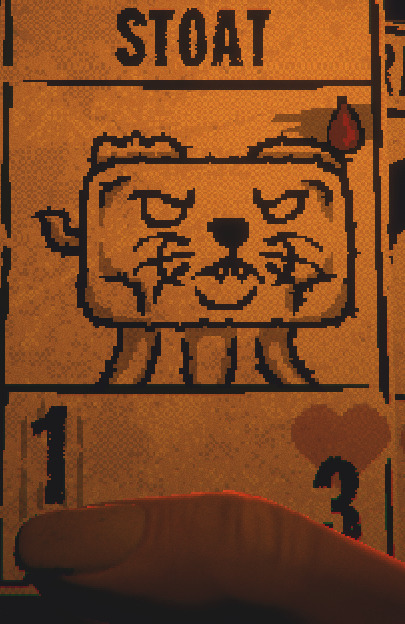

P03 was introduced to us as nothing more than one card in our deck. He wasn't even a good card. But now it's Act 2 and we realise he, along with the other three Scrybes were trapped in lesser forms by Leshy when he took control of the game. For a whole act, we see something close to a status quo with these guys, who bicker and fight over control of the disc.
We see P03's true form in all it's 16-bit glory, as well as the environment he inhabits. While atmospheric, you can tell the graphics hold him back. He seems so small and pitiful. Simple and limited.
and then he takes control.

The first time I played this section, there was something so visceral about the leap. I stopped seeing P03 as an NPC inside a 90s TDC and was forced to see him as an entity haunting a cursed floppy disc. Once again, the artifice made me too comfortable, and now anything that felt more real than that became hyper real.
and no movie pulled this off quite has effectively as I Saw The TV Glow.
I am once again flashing a spoiler warning. If you haven't seen I Saw The TV Glow, do not continue reading until you have.
We are introduced to Mr Melancholy as the antagonist of a young adult fantasy series called The Pink Opaque.
Not as the antagonist of the movie we're watching, but the villain of the TV show within the movie.
Right off the bat, Mr Melancholy isn't even on our radar. Even worse, the special effects they use to portray him are laughable.

We see him once again as our lead characters stare dreamily up into the sky, further re-enforcing how silly this guys looks. I mean come on, he looks like an uncooked pancake!!
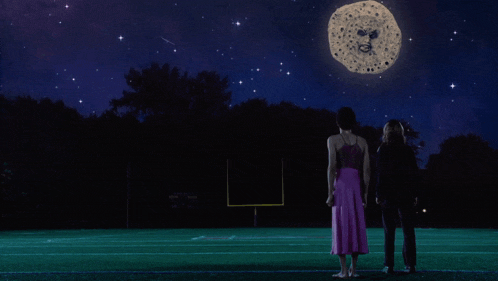
That all changes when Owen sits down to watch the final episode of The Pink Opaque, which was mysteriously cancelled after a cliffhanger ending.
The build up and climax to what happens next is one of the most harrowing cinema experiences I've had in my entire life. This is your final spoiler warning.
Isabel and Tara, the two leads in the Pink Opaque, are kidnapped by Mr Melancholy's henchmen and brought face to face with the moon man himself.

He looks... good. No, good isn't the right word... he looks convincing. The visual effects between the last time we saw him to now jumped a literal century, and combined with the crt filter hide any possible cg imperfections. In short, it make him look like he's really in the scene.
Or rather... that he's really in the room.
He gets closer, explaining his plan to trap the girls in a realm without magic or memory, where they will suffocate in the nightmare. Where they don't remember the powers they have, or the people they are. where you don't even notice the aspect ratio switched.
Where you don't even remember that you're dying.

and just like that, Mr Melancholy becomes the most real thing in the entire world. He becomes YOUR villain, he's trying to kill YOU! He's already succeeded in killing YOU. YOU are SUFFOCATING right now and you don't even KNOW!
and that's when you remember to breathe.
123 notes
·
View notes
Text
June 1, 2025 -
Tae is active on Weverse, the first day of pride month! He changes his name to Elio on Weverse.

And explained his reasoning for the change:


Some are trying to say this is based off an unreleased Disney animation, and some are excusing this as a name picked in childhood, never mind the fact it doesn’t make sense for a Korean child to pick an Italian name in an English fairytale school (credit to Sneaky Ninja on Twitter for wording this perfectly). There’s also this to debunk that theory -

Tae has been referencing the queer film, “Call Me By Your Name” since 2019, with the main character’s name being Elio. While I usually add a disclaimer for speculative content, I don’t feel it’s necessary this time. Tae mentioned “Elio” on the first day of Pride Month, a direct nod to a film he’s expressed affection for over the years. To me, the message is clear, regardless of how others might try to interpret it differently. It would be a disservice not to acknowledge how consistently Tae has referenced CMBYN, so here’s a recap:
On May 30, 2019, on the heels of pride month, Tae first mentions the movie to Hobi during a Weverse live:

https://x.com/taekookfolder/status/1137487710787112965?s=46&t=StSwHjW0_Domk_lHUFMaCg
And on the same day, he played the OST for the movie while pretending to play the piano:

https://x.com/bts_twt/status/1134534511591612418?s=46&t=StSwHjW0_Domk_lHUFMaCg Recap - https://www.tumblr.com/taekooktimeline2019/625212551783907328
On June 9, 2020 (also during pride month) Tae reads Elio’s father’s important message. For me personally, this was the biggest individual statement from Tae.

https://x.com/courtjester_tk/status/1929136113425223815?s=46&t=StSwHjW0_Domk_lHUFMaCg https://x.com/jinniestae/status/1270609532029267968?s=46&t=StSwHjW0_Domk_lHUFMaCg Recap - https://www.tumblr.com/taekooktimeline2020/625387601649713152
The next day after reciting this impactful speech, Tae goes on Weverse and says, “I want to be happy too🥺.”

https://www.tumblr.com/taekooktimeline2020/625387582497439745/june-10-2020-in-a-suspicious-chain-of-events
On September 4, 2023, Tae’s song “Rainy Days” is cited to follow the “tomato girl summer” trend, which was inspired by movies like “Call Me By Your Name.”

Recap - https://www.tumblr.com/taekooktimeline2023/727548456756035584
On January 29, 2024, Tae’s hairstylist, Mujin, interviewed with Harper’s Bazaar Korea. He shares that Tae’s style and the concept of the pictorial were planned in advance, with the male, coming of age, romantic drama “Call Me By Your Name” (CMBYN) being an inspiration (and also the movie “Blue Is the Warmest Color”.

Recap - https://www.tumblr.com/taekooktimeline2024/741046153074950144
On July 9, 2024, photos from Tae’s “Type 1” were revealed. One photo was the Hello Kitty plushie that he and Jk share, but he was also photographed in an Allsaints “love my way” shirt. The collection celebrates different love stories, is based on the song “love my way” by the psychedelic furs, and was used as a soundtrack in “Call Me By Your Name.”

Recap - https://www.tumblr.com/taekooktimeline2024/756824652406554624
In addition, Tae responds to two JK profile photos. The first user also has “Ku” in their name. I really like the adorable theory between the username, Jk photo, and the fact it was taken when Taekook were spending time together before Jk flew to Qatar (and also because Tae consistently sets boundaries with fans), that his response to the Weverse post is more playful and geared “for” Jk, rather than a fan. Of course, this is speculative but it was a cute thought on the timeline that I wanted to share since it made me smile. Nevertheless, the important thing to note is Tae responded to a Jk profile photo, which was a photo taken during their private time together before Jk’s big trip to Qatar. See Weverse message (two translations), Tae’s response and expanded profile photo he responded to):


For the above photo, as mentioned above, this was a photo that was shared directly on Tae’s IG stories. The next day, Jk flew to Qatar to promote the World Cup.
recap of this photo - https://www.tumblr.com/taekooktimeline2022/718948446462148608
The other Jk profile photo Tae responded to:

He also responded to this Taekooker profile:

#taekooktimeline#taekook#2025#call me by your name#lgbtqia#queer movies#supportive#hinting#Elio#Weverse
39 notes
·
View notes
Text
Maybe We’re obsessed with visual culture bc it takes the place of the effort it takes to actually something to say, with words. That aren’t so sexy or edgy. Some thing critical and non absolute
sometimes I feel like given we are the kids of the internet we are fed pictures, videos, branding ect before we can find our voice
I think of how much it takes to nurture my own thoughts and what they feel like in me
what they conflict with in me
How we kinda have a hard time excepting complexity
but there’s something so digestible about a photo even the ones I find most hard to see.
There’s no real release from critical thought there’s no ultimate end point to rest in
I find this troubling in my own mind the Amount of influences scream at me before I can form and nurture, question, a thought
I just started really getting into my personal research and the more I read the more I find my own inner voice full of challenge and wonder of the things around me
Vs my photo research wich is full of instinct and feeling
But now I look at my relationship to pictorial culture differently and less instinctively and more of critical selection and intimate evaluation
I’m greatful for taking the time to access what it is I’m feeling / seeing in photos and how I can use the quick feelings to engage with ideas aswel and a critical eye to challenge and work with them
it’s okay to not have anything to say about anything
aswel as nothing to show aswel
Hm
I’m rambling now but yeah
169 notes
·
View notes
Note
Continuing on the last ask about learning to start drawing OCs, do you have any tips on developing styles? I find it really difficult to “let go” of the need for things to be proportional or physically accurate, but I really want to start developing a more cartoon style.
Hi! In reference to this last post. I'm going to site a lot of stuff from a book called Understanding Comics: The Invisible Art by Scott McCloud. It's a great resource for anyone interested in cartooning, visual art, and comics as a unique storytelling art form.

Cartooning, whether it’s for comics or animation, is a very utilitarian art form. Cartooning skills and an artist's style are often forged in the hellfire of a deadline. For example, what my art style looks like when I've drawn an 80-panel comic in one week looks very different from a single illustration I’ve done in that same time frame.
Cartoonists simplify for the function of needing to draw everything by hand over and over and over again. But we also simplify for the emotional universality of the cartoon image! As stated by McCloud in the following three images.



Technically all 2D art is a form of caricature because we are reducing our 3D reality onto a 2D plane - which inherently abstracts form. Anytime someone sits down to draw (or write), they're engaging with a level of representation within pictorial space.
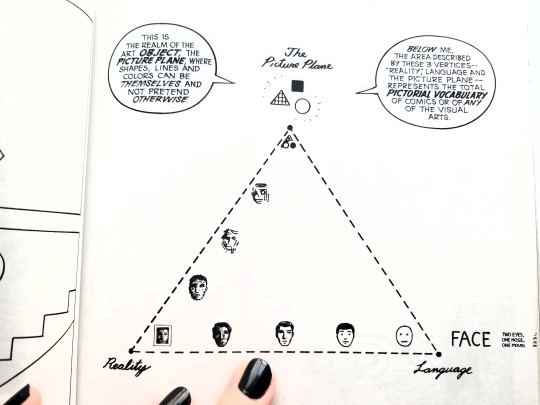
As an artist, we inevitably work in all modes at some point or another. But I think most artists will show a preference towards different corners of this diagram and that influences their style!
Ask yourself: where would you place the style you're seeking to achieve on this triangle? There's a more detailed version below with many cartoonists and styles for more examples.

I like this diagram especially because it shows the wide variety of cartoonist's styles. That's why this ask has been particularly tricky for me to answer. It's hard to give advice on becoming more cartoony without knowing what that specifically means for you, anon!
That said, I can still give some general good practice tips that hopefully anyone can utilize in their cartooning journey!
Figure drawing. Short poses (1-5 minutes). Figure drawing from life is ideal because life very rarely sits still. If you don't have any figure drawing studios in your area then go to libraries and coffee shops. You can also ask friends or family to sit for you. And finally there are figure drawing resources online that often include timers. Tip: Try drawing only with ink so you can’t erase. You won't have to do this forever but it's a great way to live with the "happy accidents" and then move on to the next drawing!
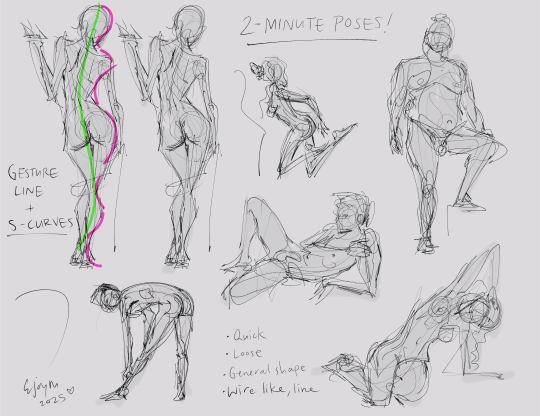
2. Gesture lines and S-curves. The gesture line captures the initial motion of the pose and will often follow the direction of the spine! S-curves are the alternating "S" shaped curves that represent the distribution of weight across the body. Exaggerating the S-curves is how cartoonists and animators often push the expressive form of the figure. When drawing the figure try to find the gesture line first and then build the weight of the pose on top of that!
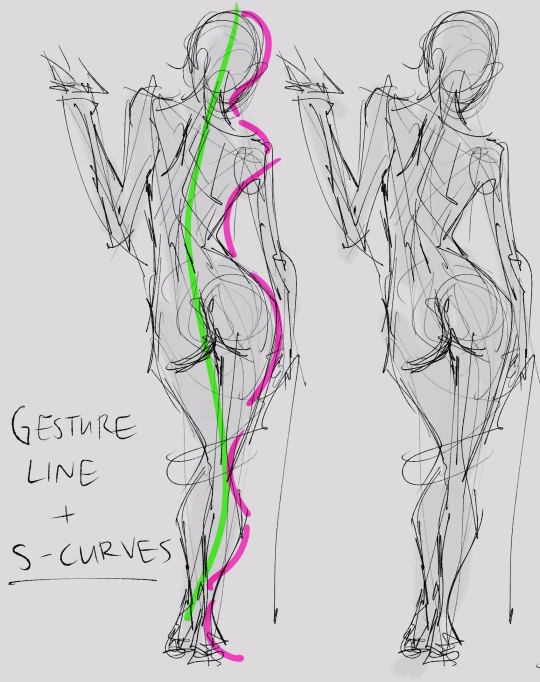
3. Give yourself a deadline. Set a timer. Stick to it! Even if all you manage is a quick line gesture. Just move on to the next pose!
Finally, I really recommend reading Understanding Comics by Scott McCloud! It's a wonderful resource that anyone interested in the visual arts could benefit from reading. I first read it 17 years ago, back in my high school film class.
Phew! That's a long one. Hopefully, there's some useful info in there for you. But do feel free to ask any follow-up questions. And good luck on your cartooning journey! 🖤
(There's also another ask in my inbox about drawing cartoonish expressions. I'm working on a response but it may take a little bit. But don't worry, I'll have a detailed answer to that in the coming weeks!)
44 notes
·
View notes
Text
Fanbinding: If It Snows or Thaws by Acephalous

#19
If it Snows or Thaws by @acephalouscreature (illustrated by @awhbeans)
Date Completed: 2/25/2025
Size: Octavo. 10,315 words, 93 pages.
Copies: 2
11th & 12th books of Binderary

Last books of Binderary!
I wanted to make another octavo and this story was a great option. It’s a Terror fic where instead of setting out for Backs Fish River the expedition makes for the supply cache at Fury Beach. I really enjoy Jopson’s steady competency throughout.
Octavos are a great way to use up scraps, and the goal was to make the books look like they might have been on the expedition. I was quite pleased with the results until it came time to mail off the artist’s copy and I realized how utilitarian it all looked. C’est la vie! At least the endpapers add a bit of interest and there's the lovely illustration to look forward to at the end.


Typeset in LibreOffice Writer with Liberation Serif body text and AR Julian for the titles. Title page motif from an old Art Nouveau Dover Pictorial Archive.

#fanbinding#binderary 2025#octavo#If It Snows or Thaws#acephalous#awhbeans#the terror amc#jopzier#thomas jopson#francis crozier#fanbinding 2025#quarter cloth
48 notes
·
View notes
Text
A train simulation at the heart of Japan's videogame production genesis
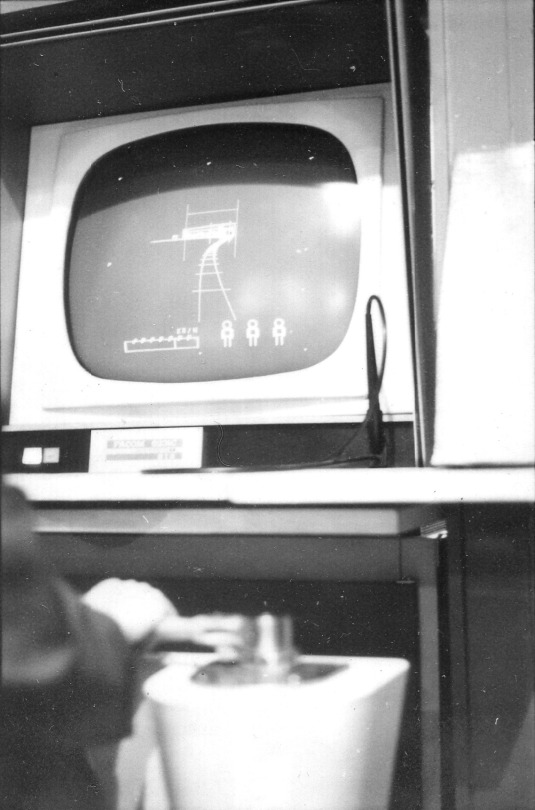
As the great videogame historian Florent Gorges explains in a recent video, one of the most beguiling developments in Japanese videogame history research comes to us from an unlikely source. Twitter user and train aficionado @yota8nsx reminisces about an episode of his childhood, namely his visit to Expo '70 in Osaka, describing a particularly captivating train simulation game playable at the Furukawa Pavilion and whose implications, if properly understood, make this one of the most important findings in this field of research.
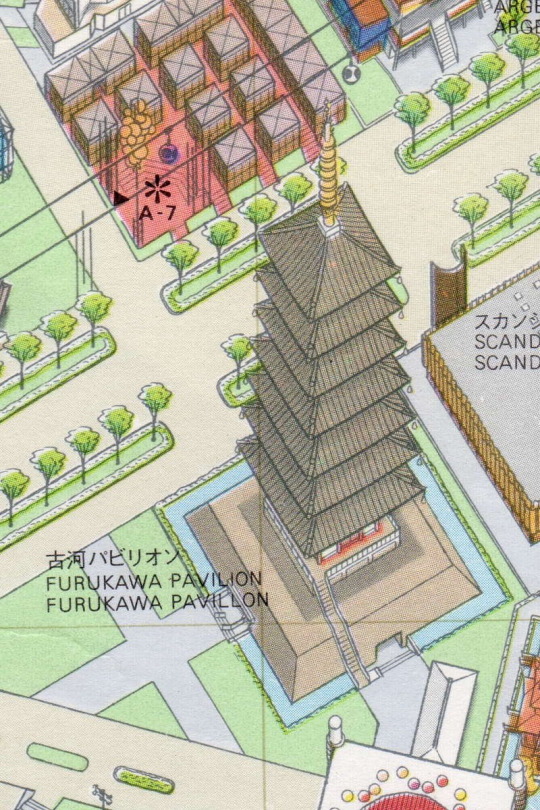
A flyer illustration of the seven story pagoda building created specifically for the occasion, a traditional architectural reference that contrasted with the latest high-tech creations hosted within it.
Late last year, @yota8nsx uncovered pictures of the exhibit captured from a speciality magazine that show this early simulation game appearing to use vector graphics to depict a train track, as well as some custom-made mechanic train cab control levers. He captions the pictures with his memories of how the program functioned:
Well, there was a limit to what could be done given the capabilities of computers in the 1970s. This is an article on page 61 of the July 1970 issue of Railway Pictorial magazine and an image taken by an acquaintance of mine. (...)
It was over 54 years ago, so my memory is a bit hazy, but I think when I accelerated, I would fall backwards, and when I braked, I would fall forwards. There are about three different angles of reclining, and each was scored based on how comfortable the ride was. If I had gotten 90 points out of 100, I would have received a medal. In the picture, it's 76 points.
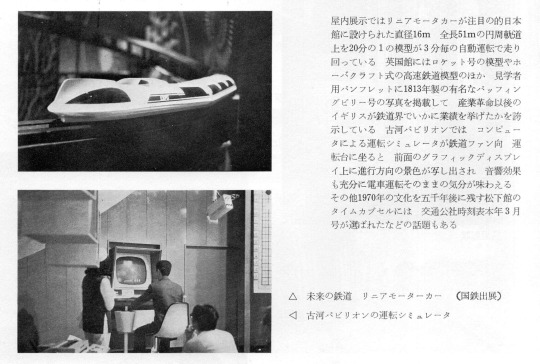
After performing some complementary research I was able to find that the program ran on an IDI Input-Output Machine, a computer developed in the mid 60s by New York-based company Information Displays, Inc. The IDIIOM is widely regarded as the first commercial CADD platform with powerful vector graphics capabilities and a light pen interface. Another game known to have been developed using the same machine is the Daly CP (Chess Program), one of the earliest GUI-based chess games, authored in 1969 by NASA researcher electrical engineer Chris Daly.


However, there are reasons to believe that this was either an adapted Japanese version of the system; or that it was in some manner connected to another terminal, as evidenced by code shown below the screen which appears to read Facom, followed by an alphanumeric code. As you may know, this was the name for Fujitsu's earliest computer line. Could this subtle hint refer to a separate terminal in which the actual game code was created or, perhaps even, running?
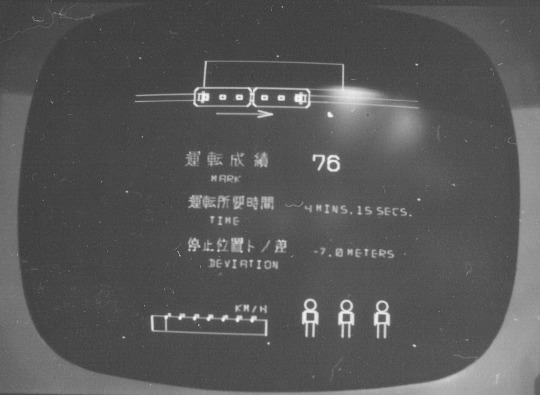
Despite the scarce information, namely the complete absence of any details concerning the authors of this magnificent experiment, there is sufficient documentation to establish this as one of the earliest known games ever to be created in Japan. Certainly, its existence is far better established than many of the often cited, Japanese university computer lab game creations from students of the 1960s.
The importance of this finding cannot be overstated, especially if one is to consider that the images hint at the distinct possibility that the game used vector graphics to represent a moving 3D train track. This some three years before Maze War, hitherto the first known game to have used three-dimensional visuals.
Disappointingly, the program itself is certain to have vanished altogether and there are hardly any leads that can explored to shed further light on this singular creation. I, for one, feel indebted to this old Japanese railfan for his invaluable contribution to what other information existed on this subject.
- Update (26/03)
The venerable Matt Sephton has pointed the way for additional information concerning this game as well as the Osaka Expo of 1970.
Some of these resources, including Classic Videogame Station, refer to this game as 電車の運転テス, or Densha no Unten Tesuto - literally Train Driving Test. Some additional photos are also provided, namely this rare colour capture showing a woman dressed as a train assistant, helping a young player. Unfortunately, this image doesn't offer additional visual access to the control levers, a crucial component of the experience.

Writing on the door reads: "warning to all visitors: this game is only available to elementary school students and above".
Further context is provided about this section of the exhibit, named Computopia. As it happens, the train simulator is only one from a handful of interactive experiences on offer on the floor of the so-called experimental theatre. Another blog post shows a cropped capture from an Expo 70 flyer, in which a brief and telling description can be read:
The modern dream is a convenient and fun utopian world made possible by computers. Furukawa Pavilion's Computopia will be an experimental theatre where all these dreams can come true, with exciting shows using the latest domestically produced computer system, the Fujitsu FACOM.

Other playable attractions included a voice-activated crane game, possibly a catcher-type arcade; a computer version of the age-old game Go that, unsurprisingly, required two players; a computer dress designer app allowing users to dabble in fashion creation, as well as a demo for a voice-activated cashless shopping system.
This floor exhibit and concept of a computer utopia was put together by the Bankoku Haku Furukawakan Promotion Committee, a parent group of the Japanese giant Fujitsu. The choice of interactive games was a deliberate decision to present computers as systems that could enable captivating and pleasurable experiences, and with it influence public perspective.
These attractions were prepared using four Fujitsu FACOM 270-30 systems, programmed by thirty engineers over a period of two years. My previous supposition that the IDIIOM computer was integrating with Japanese computer technology is thus confirmed, as the 270-30 was a powerful processing line printer-based mainframe which nevertheless lacked a visual output capability.

It is quite astonishing that Fujitsu engineers found not only a method to integrate both systems, but to harness the processing power of 1968 machine so as to enable a 3D audio-visual experience with contextual sound output (braking, crossing bridges) and complex input operations (acceleration, deceleration).
As per the Classic Videogame Station report, IBM's exhibit also included numerous other games including an early version of Lunar Lander as well as a rather complex airplane simulation. It isn't clear from the available reporting whether these programs originated in Japan or if they were developed in the United States. Sadly, this tends to muddy the waters somewhat whenever an attempt is made to establish a precise timeline of early Japanese computer game production, including the not so trivial matter of which one can claim for itself the title of being the first. At the present stage of my research, that is likely a distinction owed to the two-player Go game of which I have found written mentions placing it as far back as 1968, possibly 1966.
Be that as it may, Densha no Unten Tesuto could still be regarded as the first original videogame created in Japan that fits most parameters of contemporary gaming experience, including a well-defined arcade-like setup and presentation, a performance score and the potential for the player to win awards for achieving score targets. Chronological considerations aside, it compels us to see the history of videogames from an entirely different perspective.
Online sources and further recommended reading:
Florent Gorges Video Report at Playhistoire:
- Le Tout Premier Jeu Video Japonais Retrouvé
Yota8nsx post on visiting Expo 70:
- https://x.com/yota8nsx/status/1172335870659026951
Twitter thread covering early Japanese games:
- https://threadreaderapp.com/thread/1352188581960269828.html
Blog posts on Densha no Unten Tesuto:
- http://oyexp.blog.fc2.com/blog-entry-155.html
- https://ameblo.jp/kwkt666/entry-12479764013.html
Additional information about Expo 70 and Comutopia:
- https://www.expo70-park.jp/cause/expo/furukawa/
Specs sheet for FACOM computer line.
- https://museum.ipsj.or.jp/en/computer/main/0106.html
About the IDIIOM computer and its use for game development:
- https://www.chessprogramming.org/Daly_CP
- https://www.semanticscholar.org/paper/Was-the-IDIIOM-the-First-Stand-Alone-CAD-Platform-Bissell/b1fb4f9208fd3acd459d0efa228ebbf32b772cb7
#1970#osaka expo#japan world expo#arcade#train simulation#train#videogame#japanese#IDIIOM#vector graphics#early 3D#DACOM#Fujitsu#Youtube
21 notes
·
View notes
Text


Zaha Hadid throughout her career pushed the boundaries of architecture: defying conventions Hadid pursued her very own idea of architecture as a flow of space. Although she operated in the context of the digital turn, her calligraphic drawings remained an analog basis of her work, just like her even more spectacular paintings: already during her student days at Architectural Association London she started painting as a means to explore the spatial potency of architecture. At the same time it offered the opportunity to work out spatial „grafting“ as introduced by her teachers Rem Koolhaas and Elia Zenghelis, a method that establishes both spatial and representational constructs that Hadid realized in the painting „Malevich’s Tektonik“ and the painting related to 59 Eaton Place.
Through the years her paintings went through different transformations but continued to remain an essential tool in the development of her architectural vision. In her recently published book „Zaha Hadid’s Paintings - Imagining Architecture“ scholar Desley Luscombe follows this development and provides in-depth analyses of key paintings and how they relate to Hadid’s architecture. Proceeding from the aforementioned early paintings Luscombe in six chapters e.g. covers „Grand Buildings“ from the mid 1980s and Hadid’s engagement with the urban character of London, the Berlin project for an office building on Kurfürstendamm and ultimately the MAXXI in Rome. In each of the chapters the author elaborates on the manifold aspects that informed the paintings, e.g. layered, relational architectural ideas, precedent images by, among others, Malevich and El Lissitzky, as well as the painterly implications directed at the viewer and his/her activation and interpretation. In so doing Luscombe achieves detailed analyses that pay as much attention to the autonomous artwork as they do to its architectural dimension, an approach that brings the reader closer to understanding the purpose of painting in Hadid’s oeuvre: in painting, just like the Suprematists, she used the pictorial space to investigate topics like the spatiality of urban experiences, the role of architecture in the city or the very nature of the architectural program. Accordingly, they go well beyond a concrete, realizable building and very much distill theoretical thoughts about architecture and urbanism into series of paintings.
With Luscombe’s book Zaha Hadid’s paintings finally receive a proper scientific analysis that convincingly explains their meaning and function within the architect’s complex oeuvre. An eye-opening read!
34 notes
·
View notes
Text
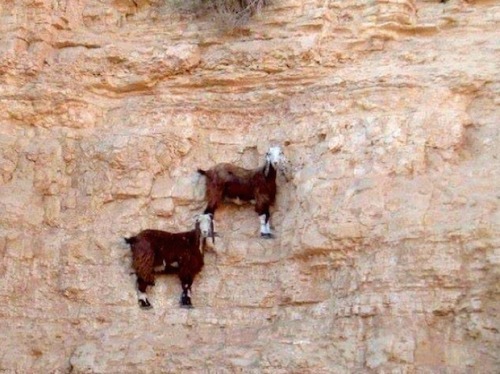
How on earth did these goats get there?
*****
In reality the goats are lying on their sides on rocky ground, looking up at a crane-mounted camera. The photograph was taken some years ago, part of a series reconstructing Central European folk customs and traditions which have fallen from favour or are now prohibited.
This old-fashioned rural blood-sport was originally practiced in parts of Anatolia, Turkey, where the game was called keçi fırlatmak, and also in the Carpathian Alps of Romania, possibly imported during the Ottoman conquest. The name there was aruncarea caprei.
*****
The goats would have been coated in a strong adhesive traditionally distilled from pine resin.(represented pictorially here by darker patches of dye on the flanks) and were then thrown upwards towards a cliff or rock-face with makeshift catapults, often a primitive form of counterweight trebuchet assembled from wooden beams and weighted with rocks.
The game ended when the glue dried and lost adhesion, and the goats fell to their deaths. They were then cooked and eaten, their meat being valued like that of Spanish fighting bulls.
The meat of the last goat to fall (başarılı keçi or cea mai durabilă capră) was prized as a special delicacy and selected cuts from the legs of this particular “winner” goat were often smoked and dried into a kind of jerky.
*****
In his “Grandes Histoires Vraies d'un Voyageur le 1er Avril” (pub. Mensonges & Faussetés, Paris, 1871) French folk-historian, anthropologist and retired cavalry general Gilles-Etienne Gérârd wrote about witnessing a festival near Sighișoara, Transylvania, in 1868.
There he claims to have seen catapults improvised from jeunes arbres, très élastiques et souples - “very springy and flexible young trees” - which were drawn back with ropes and then released.
Bets were placed before the throw, and marks given afterwards, according to what way up the goats adhered and for how long. The reconstruction, with both goats upright, facing outward and still in place, shows what would have been a potential high score.
The practice has been officially banned in both countries since the late 1940s, but supposedly still occurred in more isolated areas up to the end of the 20th century. Wooden beams from which the catapults were constructed could easily be disguised as barn-rafters etc., and of course flexible trees were, and are, just trees.
*****
Gérârd’s book incorrectly calls the goat jerky “pastrami”, to which he gives the meaning "meat of preservation".
While pastrami may be a printing error for the Turkish word bastırma or the Romanian pastramă, both meaning “preserved meat”, at least one reviewer claims that Gérârd misunderstood his guide-translator, who would have been working from rural dialect to formal Romanian to scholarly French.
Since this jerky was considered a good-luck food for shepherds, mountaineers, steeplejacks and others whose work involved a risk of falling, Gérârd's assumption seems a reasonable one.
However, several critical comments on that review have dismissed its conclusion, claiming "no translator could be so clumsy", but in its defence, other comments point out confusion between slang usage in the same language.
One cites American and British English, noting that even before differences in spelling (tire / tyre, kerb / curb etc.) "guns" can mean biceps or firearms, "flat" can mean a deflated wheel or a place to live, "ass" can mean buttocks or donkey and adds, with undisguised relish, some of the more embarrassing examples.
This comment concludes that since the errors "usually make sense in context", Gérârd's misapprehension is entitled to the same respect.
*****
The good-luck aspect of the meat apparently extended to work which involved "falling safely", since its last known use was believed to be in ration packs issued to the 1. Hava İndirme Tugayı (1st Airborne Brigade) of the Turkish Army, immediately before the invasion of Cyprus in July 1974.
Nothing more recent has been officially recorded, because the presence of cameras near military bases or possible - and of course illegal - contests is strongly (sometimes forcefully) discouraged, and the sport’s very existence is increasingly dismissed as an urban or more correctly rural legend.
The official line taken by both Anatolian and Carpathian authorities is that it was only ever a joke played on tourists, similar to the Australian “Drop-bear”, the Scottish “Wild Haggis” and the North American “Jackalope”.
They dismiss the evidence of Gérârd’s personal observation as “a wild fable to encourage sales of his book”, “a city-dweller’s misinterpretation of country practices”, or even “the deliberate deception of a gullible foreigner by humorous peasants”.
And as for those paratroop ration packs, Turkish involvement in Cyprus is still such a delicate subject that the standard response remains “no comment”.
89 notes
·
View notes
Text
𝓦HO 𝓘S ✶ 𝓢ELENE




ᴺᴼᵂ ᴾᴸᴬᵞᴵᴺᴳ : get to know selene ✶⋆.˚
SELENE ALEXANDRA KHAN ★ (𝐛. June14 ◞ 𝟏𝟗89) A rockstar, supermodel, and fashion icon, Selene defined the early 2000s with her bold, colorful alternative style and unparalleled influence in the beauty and music industries. Crowned the "Queen of Rock," Selene's legacy is immortalized through her musical versatility, fashion-forward image, and global impact. With millions of fans, she holds the title of the most-followed German individual on Instagram and has been affectionately dubbed the "Human Chanel" as a global ambassador for the iconic brand.
── .✦ EARLY LIFE ★ Born in Almaty, Kazakhstan, selene grew up as an only child with a deep passion for music. Inspired by her father, who she credits for "teaching her everything," Selene began playing guitar at a young age. At 10, her family moved to Germany, her mother's homeland, where she met her lifelong friends and future bandmates, Tom and Bill Kaulitz. As next-door neighbors, the trio bonded instantly, dreaming of stardom from a young age. "We used to perform mini concerts in my parents' living room," Selene recalls. "But I don't think we ever realized how far we would actually go.”
── .✦ MUSIC CAREER ★ In 2003, Selene co-founded the iconic alternative band Tokio Hotel, a five-member group under Universal Entertainment. Their explosive debut album, Schrei, was released in 2006, featuring the hit title track Schrei. Known for their powerful vocals, eclectic style, and captivating performances, Tokio Hotel amassed international acclaim, becoming the first German group to win major accolades from MTV, the Grammy Awards, the AMAs, and Billboard Music.
In 2008, Selene's solo career took off with her debut album "SELENE", which broke records by selling 1 million copies worldwide in record time. Her efforts earned her the "Artist of the Year" award. Despite her solo success, Selene has remained committed to Tokio Hotel, affirming, "I'll never stop making music with my band."
── .✦ MODELING CAREER ★ Selene's venture into fashion began with Chanel Beauty in 2006, where she starred in her first pictorial for Vogue Germany. Her unique style and loyalty to the brand secured her position as Chanel Germany's ambassador that same year. By 2007, Selene had ascended to global ambassador status, attending her first Chanel fashion show during Paris Fashion Week and making her unforgettable Met Gala debut in a vintage Chanel 1992 couture gown.
Her collaboration with Chanel ignited a remarkable modeling career, leading to partnerships with Calvin Klein, Chrome Hearts, and Victoria's Secret, among others. Selene made her runway debut by closing Victoria's Secret's Miami fashion show in 2008, captivating designers and inspiring countless collections. Her influence cemented her as one of the era's most celebrated supermodels and an enduring icon.



↳-the photos I use in my posts are NOT my face claims (I scripted my own face) I just use these images for similar vibes-༉‧₊˚✧
ᯓ★ SELENE ✶⋆.˚
☆ birthday: June 14th 1989
☆ gender: female (she/her)
☆ romantic orientation: bisexual
☆ relationship status: single (as of june 2009)
☆ birthplace: Almaty, Kazakhstan
☆ currently living: Berlin, Germany
☆ career: 2nd guitarist/vocalist for Tokio Hotel, brand ambassador/model for Channel
☆ AFFILIATIONS: Tokio Hotel, Chanel, MTV, BigBang, Victoria Secret, High Fashion, Formula1
ᯓ★ FUN FACTS ✶⋆.˚
☆ she’s been playing guitar since she was 5 years old
☆ hobbies: playing guitar, singing , writing, skateboarding, street racing, and soccer
☆ faves: singing, playing guitar, traveling, fashion, socializing, rollercoasters, racing cars, anything adrenaline inducing
☆ she speaks German, Kazakh, Korean, English, and Russian
☆ she dyes her hair a different color almost every month
☆ gold jewelry, cheetah print, and ripped leather jackets are her staples.

#dr intro#fame dr#band dr#kpop dr#reality shifting#shifting#shifting blog#shiftblr#© starrgirll444 ༉‧₊˚.#☆ star’s realities ༉‧₊˚.#☆ star (selene version) ༉‧₊˚.
14 notes
·
View notes
Text
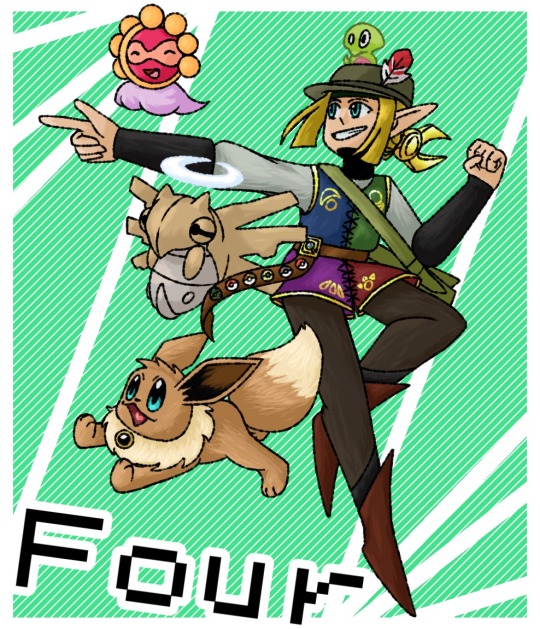
Four for the Pokémon AU! He has an X&Y inspired design. Gave him the hat with the feather pin that’s now a Minish Feather, and also gave him this kinda ponytail thingy that is covered by an Ezlo charm. It’s weird but I like it.
I didn’t put in all of his Pokémon because i just couldn’t make myself draw them(Swampert and Azumaril). I only recently noticed how short I made the tunic. The anatomy’s just kinda wonk, but I can’t really fix it now. I also tried a new rendering style. I don’t know how to feel about it. Anyways, Lore under the cut.
At the beginning of the Minish Cap, Link doesn’t get a starter. Instead, he gets his starter once he meets Ezlo, who suggests to get a Pokémon companion to help out, since he can’t really do much. Because at the moment, he was a hat. Link choose Mudkip because he thought it could help him get over the water easier. That did not work.
Link also transforms into an actual Minish, who are a Pokémon in the same vein that the Zora and Gorons are also Pokémon. Pokémon=species, more of less. Pokémon-Mystery-Dungeon-esk, but not as much as Twilight’s adventure was. Four’s adventure was more or less the exact same, and he didn’t really use Pokémon all that much, just the Pictori sword/Four sword. But he did catch a bunch of Pokémon, because he was really into collecting things back then(like how there were a bunch of figurines in the actual game).
He found a Maril near the beginning of his adventure and thought it was cute so he kept it. He specifically wanted a shiny Shedinja because no one in Castle Town had ever seen one up close. He did not that shiny after hours of hunting. So in the end, he just got a regular Nincada and named his Shedinja NotAShiny, because he was so annoyed. Link did come to love it tho, so he usually calls him Nota for short.
At the beginning of Four Swords(and let’s just combine fsa because who cares), Link became friends with an Eevee, right before the maidens got kidnapped. Stuff happened and both Link and his newfound Eevee end up at the Four Sword Sanctuary, where Link had stored the Four Sword after his first adventure. The sword had been accumulating more and more magic since Vaati’s imprisonment within it. I don’t know how the story works in LU canon, but that’s how it works here.
The 4Sword not only splits Link up into four, but Eevee as well, the sword reacting to the uniqueness of Eevee’s genes or something. Leafeon for Green, Flareon for Red, Vaporeon for Blue, and Espeon for Vio. Also because of Eevee’s wild genes, the 4Sword clings to it and its spilt eeveelutions, and can only be pulled out by the colors. I mainly came up with this because I couldn’t figure out where to put the sword on Four’s design.
Link found the Castform early on, his first shiny on this adventure(he found shinies before but he liked this one especially so he had it in his team at the moment he went through the portal). Link also found the Zygarde Core sometime during the adventure. His collecting instincts kicked in whenever he found the cells. He can make Zygarde become 100%, but he likes the Core form best.
Btw, Shadow never had any Pokémon of his own. He’d order around Pokémon provided by Ganon. He would befriend a Masquerain and would love it forever. He’d say he doesn’t but he does.
I don’t really have any ideas about LU specific stuff right now, but I can say that Four, Legend, Wind, and Hyrule are the only ones with Mega Stones. Four’s Swampert has a mega stone.
#the legend of zelda#linked universe#lu four#four linked universe#linked universe au#legend of zelda au#loz link#pokémon au#linked pokémon#art fever
76 notes
·
View notes
Text
I just recently started to get into Sigil Magick, and of course, I gotta experiment to see how I can help others with my new learnt skills. So for a short period of time, I'll be doing free sigil magick for people, to experiment!!
What is a sigil:
"A sigil is a type of symbol used in magic. The term usually refers to a pictorial signature of a spirit. In modern usage, especially in the context of chaos magic, a sigil refers to a symbolic representation of the practitioner's desired outcome. "
Basically, you can create a symbol to achieve your desired results!! Like money, beauty, a special person, etc etc
You can head on over to my asks and fill out this form!! Keep the desire simple and easy for me to understand, not a whole paragraph long or a backstory, but also specific.
Name:
Desire:
That's it lol
Example form:
Name: Willow
Desire: Earn £1K this month through commissions
I'll respond with an image of your sigil.
Your sigil will already be charged by yours truly, depending on the topic of your desire, it can be charged differently.
Ways a sigil can be charged:
Elements: Fire, water, earth, air
Meditation
Sex magick
Energy
Exercise
OK that's all bye, I hope people are interested runs away
#reality shifting#shifting#shiftblr#shifting blog#shifting reality#shifting community#law of assumption#loa#manifesting#subliminals#witchcraft#witch#sigils#chaos magick#magick#witchcore#witchblr
24 notes
·
View notes
Text
director's commentary for this post (lmao) because I like yapping
the reason why I choose these artworks is not just because they looked good, I thought it was interesting how they treat colors, light and rot
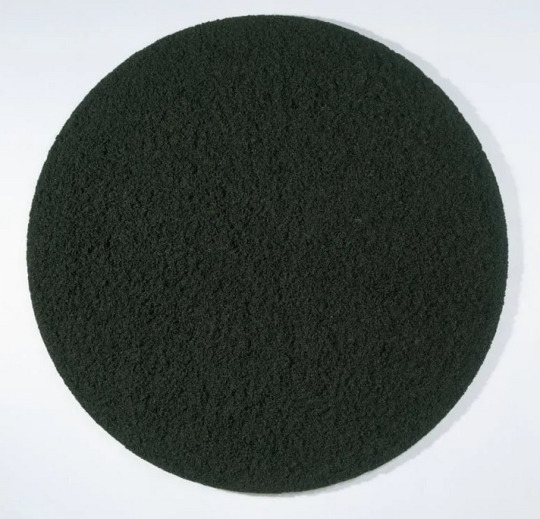
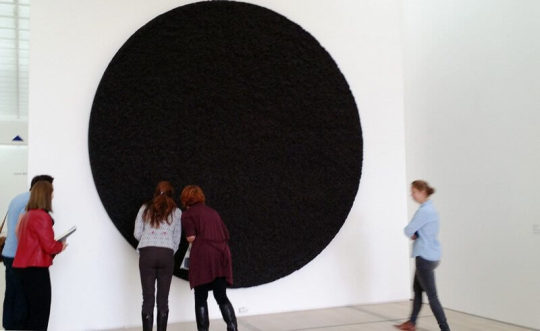
Damien Hirst's Black Sun is made of many dead flies, people have said that this artwork smells gross up close. Its theme is obviously death and disgust (like most of his works), he has also said the flies represent people, and quotes Hobbes saying that people's life without a government is bad and tragic (which I HEAVILY disagree with)
Hirst sells his works for millions of dollars, it's highly commercialized, some have accused him of money laundering and such. Insert the Wompty-Dompty Dom Centre thought:
Problem It's Wednesday evening and something heinously exciting is under way. People have gathered beneath the billowing roof of an oddly shaped trophy building, sipping wine and exchanging opinions. 29-year-old wunder-twins Guy and Keith Joost are the stars of the show, with their bomber jackets and white sneakers -- head curators of this art exhibition. It's the wompty-dom-di-dommiest event of the year and all the cool kids have RSVP’d. Where are you, if you are not there? Solution You're at home, stupid cop, not with the art crowd. You hate them, everyone hates them, even they hate themselves. It's nauseating -- an industry built on sprezzatura and sparkling wine. And, let’s be honest, tax evasion schemes. The Wompty Dompty Dom Centre is the heart of this unholy symbiosis of esthetics and tax optimization, and now that you've internalized it – you can have a piece too!
personally, for me, it invokes disgust both on an aesthetic level (dead flies) and in a conceptual level (rich guy using death to make millions). Tieing this into black being the color of money in Elysium, and the end of the world.

Malevich's Black square is a painting without an object, it doesn't represent the material world, it is independent of it. but at the same time, black is the density of matter in the white empty space.
He said this about this art: "[Black Square is meant to evoke] the experience of pure non-objectivity in the white emptiness of a liberated nothing." "It is from zero, in zero, that the true movement of being begins." (x) ‘In the year 1913, trying desperately to free art from the dead weight of the real world, I took refuge in the form of the square.’ (x)
Important context for this work (like many other black paintings) is that it was made around the time of the world wars, and the russian revolution. Black paintings express the trauma of the world wars, and in this case the revolutionary approach to art too.
quoting from the article I linked:
Malevich had been collaborating with the musician Mikhail Matyushin and the poet Aleksei Kruchenykh on a manifesto which called for the rejection of rational thought. They wanted to overturn the established systems and hierarchies of Western society. Together with poet Velimier Khlebnikov they staged Victory over the Sun, where the characters aimed to abolish reason by capturing the sun and destroying time. The libretto used Kruchenykh’s zaum – a new language of sounds that had no meaning. This sparked something in Malevich.

Similar things apply to White on white. The Moma website describes it better than I would:
[Malevich] "wanted White on White to create a sense of floating and transcendence. White, Malevich believed, was the color of infinity and signified a realm of higher feeling, a utopian world of pure form that was attainable only through nonobjective art. Indeed, he named his theory of art Suprematism to signify “the supremacy of pure feeling or perception in the pictorial arts”; and pure perception, he wrote, demanded that a picture’s forms “have nothing in common with nature.” In 1918, soon after the Russian Revolution, the connotations of this sense of liberation were not only aesthetic but also social and political. Malevich expressed his exhilaration in a manifesto one year later: “I have overcome the lining of the colored sky. . . . Swim in the white free abyss, infinity is before you.”

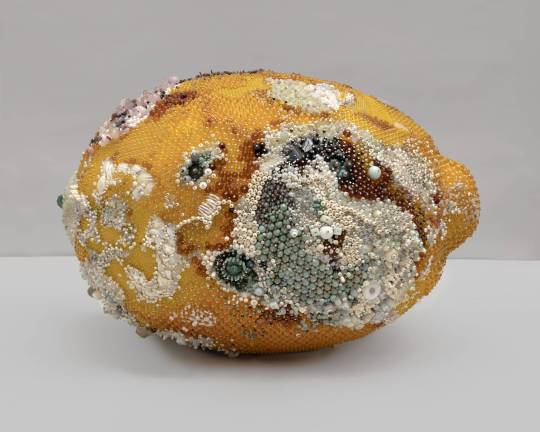
These molding fruits made out of gemstones by Kathleen Ryan make me think of Damien Hirst's bedazzled Skull artwork, decadence, kitsch, death. The gemstones make the mold feel like it has value, importance, like it's almost sacred. The pale as a "sacred and terrible smell"

Rothko's paintings heavily empathize colors, paintings like these invite us to really experience those colors and be moved by them.
From the Disco Elysium artbook:
Eyes are direct, unmediated input to the brain. You like or dislike something before you have a chance to reason about it. It affects you emotionally without offering you a chance to throw up intellectual defenses first. Witnessing death and good art are materially equivalent experiences: they are visual information transmitted straight to the centers of emotion by way of the eye. This might explain why a person could tear up in the presence of a Rothko painting. If you’re a sensitive enough instrument, seeing his Orange, Red, Yellow in real life feels intense. It doesn’t work on a computer screen though, you’re just staring at some bright pixels imitating the appearance of the painting the same way seeing a dead person is different from seeing a picture of a dead person.

El Lissitzky was also an important figure in russian avant-garde, like Malevich. Well. I put this one in here cause it looked nice and because of the theme of light and the lack of (it's a gelatin silver photograph).
maybe this adds something to the discussion of the symbolism of colors and light in Elysium
#long post /#I love art history and talking about art so much#what do i tag this#its going into my#de meta#tag
75 notes
·
View notes